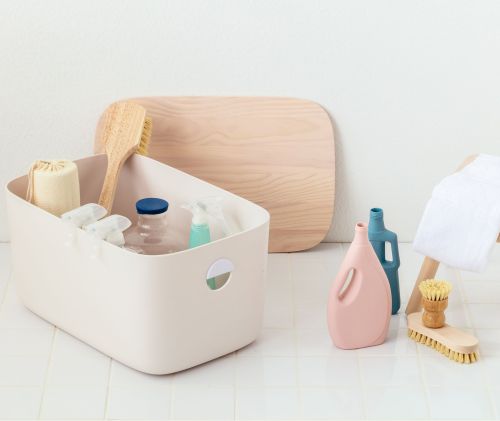Our editors independently select these products. Making a purchase through our links may earn Well+Good a commission
If you watched Selling Sunset as ravenously as I did, you know that house stagers have an instrumental role in getting a house off the market. It’s their job to show potential homeowners what the house could be at its best (sans clutter and with subtle layout or decor tweaks) so that they put an offer in, stat. A big part of doing that is making sure the environment is stress-free as possible. Luckily, you don’t need a brand-new home to learn a few stager-beloved tricks.
Experts in This Article
Janci Deetz is a home designer and stager at Studio D. in New York and Los Angeles.
According to Janci Deetz, a designer and stager at studio D.—a staging studio based in San Francisco and New York City—there’s an important distinction between a staged home and a home you actually want to live in. For example, staged houses often have minimal storage space because they don’t need extra space; in day-to-day life, you’ll probably need storage options like dressers, baskets, and hollow ottomans.
That said, Deetz has a few tricks up at her sleeves that totally translate from staged home to your address. “At home, I do use some staging tricks, like [using] mirrors, lighting, restraint, and creating curated ‘moments.’ But for me ‘stress-free’ comes with doing my best to slow it all down, enjoying the world around me and bringing my love of the outside in,” says Deetz. “I strive to continually edit the old and thoughtfully consider the new things I bring into my home.”
Below, Deetz shares the top four design mistakes that are making you feel more stressed than serene. Then, she offers solutions so you can start “staging” your home.
The top 4 home design mistakes that are making your space stressful, according to a professional stager
Mistake 1: Holding on to things that just aren’t essential
You probably won’t be surprised that Deetz says that clutter is enemy number one. “We all accumulate it and have to actively work to control it,” she says. “It creates stress because every item that you don’t use and love is a deferred decision you should’ve made and didn’t. I don’t know about you, but that gnaws at me.”
Research confirms Deetz’s distrust of clutter: Studies have indicated the presence of too many possessions may break your focus and make a dent in your daily quota of joy.
To combat clutter, Deetz recommends setting aside small blocks of time to manage the things that come into your home. If you’re getting a heaping pound of credit card offers in the mail every day, make sure you’re taking time to sort through those and toss what you don’t want. Block out an hour in your calendar and give your house a long, hard look. What belongs there? What’s making your place feel like home?
According to Deetz, this doesn’t mean stripping your home of everything extraneous; on the contrary, it will help you get clarity on what is meaningful to you. (And have room to prioritize that in your living space.) “My husband and I started collecting a bit of every place we traveled: dirt from a campsite, fall leaves from Yosemite, sea glass from our honeymoon on the Amalfi coast, sand from my 40th in Mexico, part of our Christmas ‘shrub’ from Aspen and everything in between,” she says, calling her collection “a celebration of life I look at every day.”
Mistake 2: Letting rooms in your house go unloved
Raise your hand if your dining table has been overrun with art supplies, toys, or a home improvement project you may never finish. Deetz says that a room lacking purpose can stress us out… whether we actively realize it or not. “A dining room can be a playroom and a living room an office if that works for you—but I’m a firm believer in having areas to stash your every day business in a way that still leaves your home livable and enjoyable for family meals, entertaining, and relaxing,” she says.
The fix? Storage, storage, storage. “Find easy, pretty ways to stash things when they are not in use. I’m a big fan of galvanized bins. Mine have gone from Nerf gun collectors to planters,” says Deetz. Once the items in those bins have served their purpose, however, make sure you donate them and move on.
A set of storage bins to get you started
Open Spaces Large Storage Bins - Set of 2 — $78.00
Mistake 3: Not considering the natural flow of space in your home
While it can be tempting to push everything up against the wall (your couch, tables, bed, nightstands, etc.), Deetz says you may be interrupting the natural flow of space in your living quarters—and that can cause stress. “Even though [stagers] consider the space thoroughly when planning a design, it often changes in the moment. What works on paper doesn’t always work in the space. You have to be fluid with your design and let it adapt and change as your needs do. So many of us move in and that’s it! The silverware ended up here, the couch landed there,” says Deetz.
After you’ve lived in your house or apartment for a while, you’ll be able to think: “oh, I keep bumping into that couch on my way to the dining table,” or, “It makes no sense that the pots are so far away from the stovetop.” Then, you can make adjustments. “Don’t be afraid to mix it up and play,” she says. “Maybe even change things seasonally—I do with my linens, rugs, and pillows.”
Mistake 4: Bad lighting
“Lighting, views… that’s everything! When the windows can shine, you open up your space and sightline to so much more, making the home feel bigger and more inviting,” says Deetz. Anyone who has worked in a fluorescent-lit office space will be able to confirm the importance of good old natural light, so do your best to take advantage of yours (even if it’s only the teeny-tiniest bathroom window).
Take the time to open up your blinds or curtains in the morning, and avoid blocking any windows with furniture. Placing mirrors all around your home will also help the light make its rounds around the house. Just make sure you’re also wearing that indoor SPF, fam.
Are house plants part of your new decor? Here’s how to water them properly:
Sign Up for Our Daily Newsletter
Get all the latest in wellness, trends, food, fitness, beauty, and more delivered right to your inbox.
Got it, you've been added to our email list.











